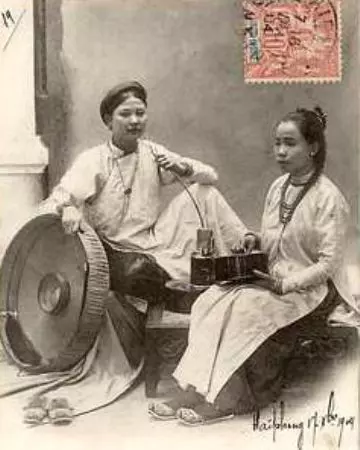This article sheds light on the Áo Dài, a key essence of Vietnamese culture that captivates hearts with its beauty and gracefulness. Jointly written by Neil Nguyen and Isabella Nga Lai, this piece combines their insights and explores the deep impression this traditional dress leaves on both locals and foreigners.
The Allure of the Áo Dài
The Áo Dài, Vietnam's national outfit, holds a special place in the hearts of its people. Worn during important occasions like Tet, holidays, weddings, and even daily by high school girls, it has become a symbol of Vietnamese tradition and elegance.
Let's take a closer look at the Áo Dài:
 Courtesy of Tran The Vinh
Courtesy of Tran The Vinh
The intricate design of the Áo Dài showcases its unique features, such as the hooks and holes (nut bam than ao) used as fasteners, the inside seam (duong ben), the main hook and hole (nut moc ket thuc), and the back flap (tà sau). These elements contribute to the dress's allure and cultural significance.
Unearthing the Origins
The history of the Áo Dài traces back to the 18th century when Lord Nguyen Phúc Khoát of Hue mandated that men and women at his court wear trousers and a gown with front buttons. This new ensemble was called the áo dài (long shirt), as described by writer Lê Quý Dôn.
 Courtesy of Kauffner
Courtesy of Kauffner
In the 19th century, the Áo Dài evolved into the áo ng? thân, featuring two flaps sewn together in the front and back. The present-day Áo Dài still retains the two-flap design with slits on both sides. Cát T??ng, a Hanoi designer, later drew inspiration from the áo ng? thân and Paris fashion to create the Áo Dài Le Mur in 1930. The designers in Saigon further refined its fit in the 1950s, leading to the modern Áo Dài.
While the Áo Dài has embraced foreign influences over time, the essence of this dress remains intact—a tight-fitting silk tunic worn over pantaloons, exuding elegance and sophistication.
 Courtesy of xcanbiet
Courtesy of xcanbiet
Colors and Symbolism
The Áo Dài comes in various styles, with each color carrying its own significance. Young girls wear the white Áo Dài as their school uniform, representing youthful innocence and their coming of age. This elegant garment creates a marvelous scene when hundreds of schoolgirls donned in white Áo Dài leave the school gates, radiating purity and innocence.
Older, unmarried girls in their mid-to-late 20s wear pastel-colored Áo Dài, symbolizing their youthful charm. Married women opt for Áo Dài in vibrant shades, often paired with white or black pants, showcasing their maturity and elegance.
Celebrating Áo Dài Contests
Áo Dài contests hold a significant place in Vietnamese traditions and are often held during Tet festival pageants. These contests demonstrate the deep-rooted appreciation for the beauty and culture associated with this iconic dress.
The Enduring Symbol of Femininity
The Áo Dài transcends its role as a mere dress; it symbolizes femininity at its finest. As a girl, Isabella finds it to be a national symbol of beauty and grace. Neil, as a boy, appreciates the elegance exuded by women adorned in the Áo Dài. How do you perceive the magnificence of the Áo Dài?
With its rich history and cultural significance, the Áo Dài continues to be a cherished garment that beautifully represents the essence of Vietnamese culture.
Featured image courtesy of Tran The Vinh.


















